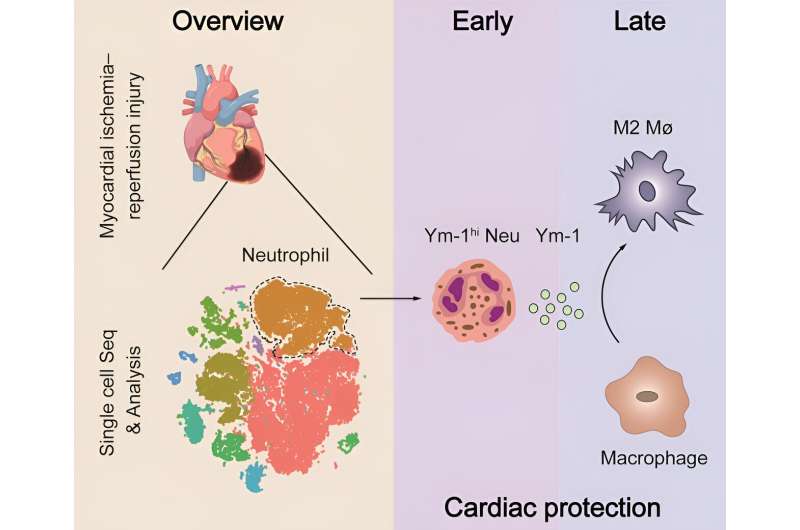This article has been reviewed according to Science X's editorial process and policies. Editors have highlighted the following attributes while ensuring the content's credibility:
fact-checked
trusted source
proofread
Single-cell profile reveals the landscape of cardiac immunity and identifies a cardio-protective Ym-1hi neutrophil

Myocardial ischemia-reperfusion injury (MIRI) is a major hindrance to the success of cardiac reperfusion therapy. Immune response mediates the pathophysiological process of MIRI, implying that regulating immune responses within a certain time window may be an effective strategy for treating MIRI.
However, there have been few descriptions of the essential role of heart-infiltrating immune cells in MIRI. Single-cell RNA sequencing (scRNA-seq) has uniqusix time advantages in uncovering specific cell characteristics and functions, contributing to a deep understanding of the cardiac, and immune cell profile and therapeutic target mining in MIRI.
A recent study published in the journal Science Bulletin was led by Prof. Desheng Hu (Union Hospital, Tongji Medical College, Huazhong University of Science and Technology), Prof. Yue Liu (Xiyuan hospital, Chinese Academy of Chinese Medical Sciences), and Prof. Shanshan Luo (Union Hospital, Tongji Medical College, Huazhong University of Science and Technology).
In their study, the researchers performed scRNA-seq of cardiac CD45+ cells isolated from the murine myocardium subjected to MIRI at six-time points and identified diverse types of infiltrating immune cells as well as their dynamic changes. Cardiac neutrophils were further analyzed as the "sentinel cells" and featured functionally heterogeneous subpopulations, including Ccl3hi Neu and Ym-1hi Neu exhibited in a time-dependent manner.
Ym-1hi Neu selectively expressed genes with protective effects and was, therefore, identified as a novel specific type of cardiac cell in the injured heart.
Further analysis indicated that neutrophils and their subtypes orchestrated subsequent immune responses in the cardiac tissues, especially instructing the response of macrophages. The abundance of Ym-1hi Neu was closely correlated with the therapeutic efficacy of MIRI when neutrophils were specifically targeted in different manners.
In addition, a neutrophil subtype with the same phenotype as Ym-1hi Neu was detected in clinical samples and correlated with prognosis, indicating the clinical prospect of neutrophil targeting therapy.
Then, the cardio-protective effect of Ym-1hi Neu was verified by experiments of Ym-1 inhibition and supplementation in mice model, and the role of Ym-1 on the polarization of macrophages toward the repair phenotype in myocardial tissue was proven to be the therapeutic mechanism of the Ym-1hi Neu in vivo and in vitro.
In conclusion, this team reveals the landscape of cardiac immunity, identifies a unique population of neutrophils involved in pathological processes of MIRI that exhibit a cardioprotective role, and preliminarily determines its potential mechanisms and clinical prospects. These findings provide a foundation for developing new therapeutic strategies involving MIRI-targeting neutrophils.
More information: Yalan Dong et al, Single-cell profile reveals the landscape of cardiac immunity and identifies a cardio-protective Ym-1hi neutrophil in myocardial ischemia–reperfusion injury, Science Bulletin (2024). DOI: 10.1016/j.scib.2024.02.003


















